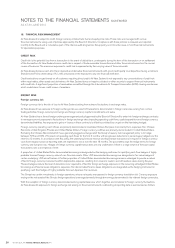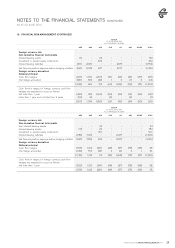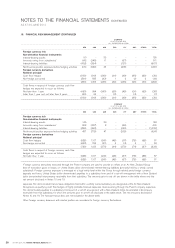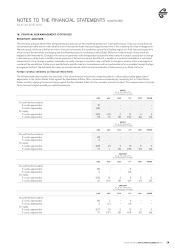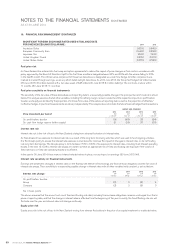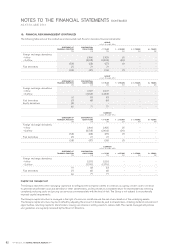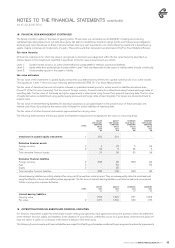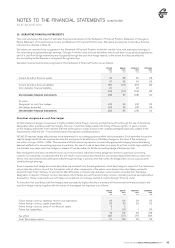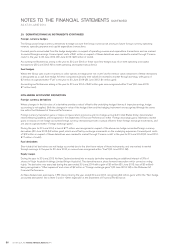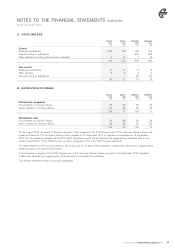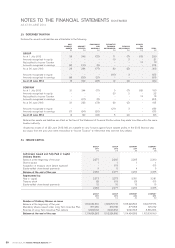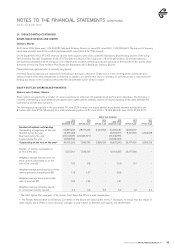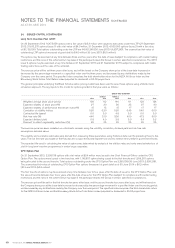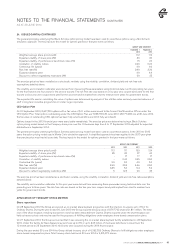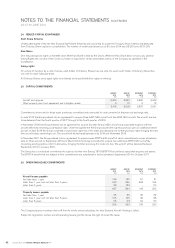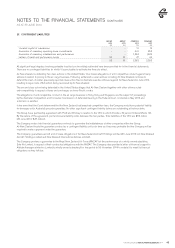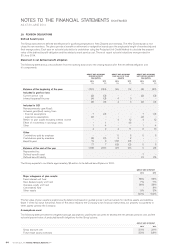Air New Zealand 2014 Annual Report Download - page 37
Download and view the complete annual report
Please find page 37 of the 2014 Air New Zealand annual report below. You can navigate through the pages in the report by either clicking on the pages listed below, or by using the keyword search tool below to find specific information within the annual report.
AIR NEW ZEALAND ANNUAL FINANCIAL RESULTS 2014 35
20. DERIVATIVE FINANCIAL INSTRUMENTS
This note summarises the impact of derivative financial instruments on the Statement of Financial Position, Statement of Changes in
Equity, Statement of Comprehensive Income and Statement of Financial Performance. The nature and purpose of derivative financial
instruments is detailed in Note 18.
Derivatives are required to be recognised in the Statement of Financial Position at their fair market value, with subsequent changes in
fair value being recognised through earnings. Changes in the fair value of those derivatives which have been successfully designated as
part of a cash flow hedge relationship are recognised through the cash flow hedge reserve, to the extent that they are effective.
Any accounting ineffectiveness is recognised through earnings.
Derivative financial instruments recognised on the Statement of Financial Position are as follows:
GROUP
2014
$M
GROUP
2013
$M
COMPANY
2014
$M
COMPANY
2013
$M
Current derivative financial assets
30 98 30 98
30 98 30 98
Current derivative financial liabilities
Term derivative financial liabilities
(57)
(1)
(13)
-
(57)
(1)
(8)
-
(58) (13) (58) (8)
Net derivative financial instruments (28) 85 (28) 90
Of which:
Designated as cash flow hedges
Non-hedge accounted
(14)
(14)
56
29
(14)
(14)
55
35
Net derivative financial instruments (28) 85 (28) 90
Derivatives designated as cash flow hedges
Air New Zealand manages its exposure to highly probable future foreign currency and fuel transactions through the use of derivatives
designated within qualifying cash flow hedges. The use of cash flow hedges allows the timing of the recognition of gains or losses
on the hedging instrument to be matched with that of the gains or losses arising on the underlying hedged exposures, subject to the
requirements of NZ IAS 39 - Financial Instruments: Recognition and Measurement.
NZ IAS 39 requires hedge effectiveness to be determined for accounting purposes within strict parameters. Each derivative transaction
used to hedge identified risks must be documented and proven to be effective in offsetting changes in the value of the underlying
risk within a range of 80% - 125%. This measure of effectiveness may result in economically appropriate hedging transactions being
deemed ineffective for accounting purposes. In particular, the use of crude oil derivatives as a proxy for jet fuel, and the high volatility of
fuel markets may cause cash flow hedges in respect of fuel derivatives to fail the accounting hedge effectiveness test.
Risk management practices are determined on an economic basis, rather than being designed to achieve a particular accounting
outcome. Consequently, it is expected that this will result in some transactions failing the accounting hedge effectiveness criteria from
time to time and ineffectiveness being recorded through earnings in periods other than when the hedged item occurs, causing some
volatility through earnings.
Some components of hedge accounted derivatives are excluded from the designated risk. Cash flow hedges in respect of fuel derivatives
only include the intrinsic value of the fuel options with all other components of the option value (mainly time value) being marked to
market through “Fuel”. Similarly, forward points (the differential in interest rates between currencies) are excluded from the hedge
designation in respect of foreign currency derivatives which hedge account forecast foreign currency operating revenue and expenditure
transactions. These components are not hedge accounted and, accordingly, marked to market through “Finance costs”.
To the extent that qualifying cash flow hedges were assessed as highly effective, a summary of the amounts that were included in the
cash flow hedge reserve, together with the nature of the hedged risk exposure is as follows:
GROUP
2014
$M
GROUP
2013
$M
COMPANY
2014
$M
COMPANY
2013
$M
Future foreign currency operating revenue and expenditure
Future foreign currency capital expenditure
Future foreign currency sales of non-financial assets
Future fuel expenditure
43
26
3
1
116
59
2
(3)
29
26
-
1
112
59
-
(3)
Tax effect
73
(22)
174
(51)
56
(17)
168
(49)
Cash flow hedge reserve 51 123 39 119
NOTES TO THE FINANCIAL STATEMENTS (CONTINUED)
AS AT 30 JUNE 2014



